wheel alignment CHEVROLET MALIBU 2008 6.G Owners Manual
[x] Cancel search | Manufacturer: CHEVROLET, Model Year: 2008, Model line: MALIBU, Model: CHEVROLET MALIBU 2008 6.GPages: 412, PDF Size: 2.22 MB
Page 252 of 412
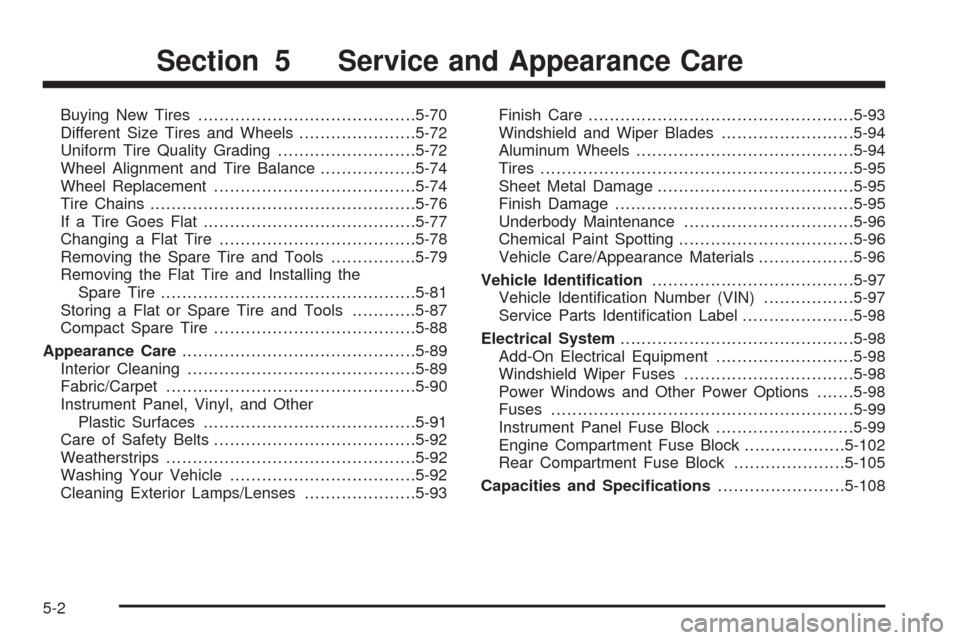
Buying New Tires.........................................5-70
Different Size Tires and Wheels......................5-72
Uniform Tire Quality Grading..........................5-72
Wheel Alignment and Tire Balance..................5-74
Wheel Replacement......................................5-74
Tire Chains..................................................5-76
If a Tire Goes Flat........................................5-77
Changing a Flat Tire.....................................5-78
Removing the Spare Tire and Tools................5-79
Removing the Flat Tire and Installing the
Spare Tire................................................5-81
Storing a Flat or Spare Tire and Tools............5-87
Compact Spare Tire......................................5-88
Appearance Care............................................5-89
Interior Cleaning...........................................5-89
Fabric/Carpet...............................................5-90
Instrument Panel, Vinyl, and Other
Plastic Surfaces........................................5-91
Care of Safety Belts......................................5-92
Weatherstrips...............................................5-92
Washing Your Vehicle...................................5-92
Cleaning Exterior Lamps/Lenses.....................5-93Finish Care..................................................5-93
Windshield and Wiper Blades.........................5-94
Aluminum Wheels.........................................5-94
Tires...........................................................5-95
Sheet Metal Damage.....................................5-95
Finish Damage.............................................5-95
Underbody Maintenance................................5-96
Chemical Paint Spotting.................................5-96
Vehicle Care/Appearance Materials..................5-96
Vehicle Identi�cation......................................5-97
Vehicle Identi�cation Number (VIN).................5-97
Service Parts Identi�cation Label.....................5-98
Electrical System............................................5-98
Add-On Electrical Equipment..........................5-98
Windshield Wiper Fuses................................5-98
Power Windows and Other Power Options.......5-98
Fuses.........................................................5-99
Instrument Panel Fuse Block..........................5-99
Engine Compartment Fuse Block...................5-102
Rear Compartment Fuse Block.....................5-105
Capacities and Speci�cations........................5-108
Section 5 Service and Appearance Care
5-2
Page 317 of 412
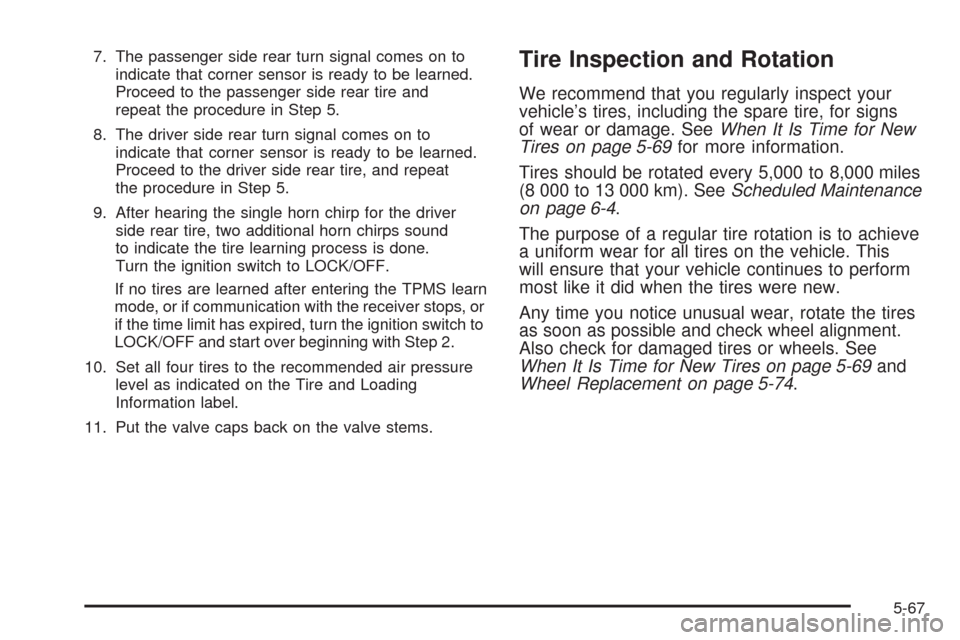
7. The passenger side rear turn signal comes on to
indicate that corner sensor is ready to be learned.
Proceed to the passenger side rear tire and
repeat the procedure in Step 5.
8. The driver side rear turn signal comes on to
indicate that corner sensor is ready to be learned.
Proceed to the driver side rear tire, and repeat
the procedure in Step 5.
9. After hearing the single horn chirp for the driver
side rear tire, two additional horn chirps sound
to indicate the tire learning process is done.
Turn the ignition switch to LOCK/OFF.
If no tires are learned after entering the TPMS learn
mode, or if communication with the receiver stops, or
if the time limit has expired, turn the ignition switch to
LOCK/OFF and start over beginning with Step 2.
10. Set all four tires to the recommended air pressure
level as indicated on the Tire and Loading
Information label.
11. Put the valve caps back on the valve stems.Tire Inspection and Rotation
We recommend that you regularly inspect your
vehicle’s tires, including the spare tire, for signs
of wear or damage. SeeWhen It Is Time for New
Tires on page 5-69for more information.
Tires should be rotated every 5,000 to 8,000 miles
(8 000 to 13 000 km). SeeScheduled Maintenance
on page 6-4.
The purpose of a regular tire rotation is to achieve
a uniform wear for all tires on the vehicle. This
will ensure that your vehicle continues to perform
most like it did when the tires were new.
Any time you notice unusual wear, rotate the tires
as soon as possible and check wheel alignment.
Also check for damaged tires or wheels. See
When It Is Time for New Tires on page 5-69and
Wheel Replacement on page 5-74.
5-67
Page 324 of 412
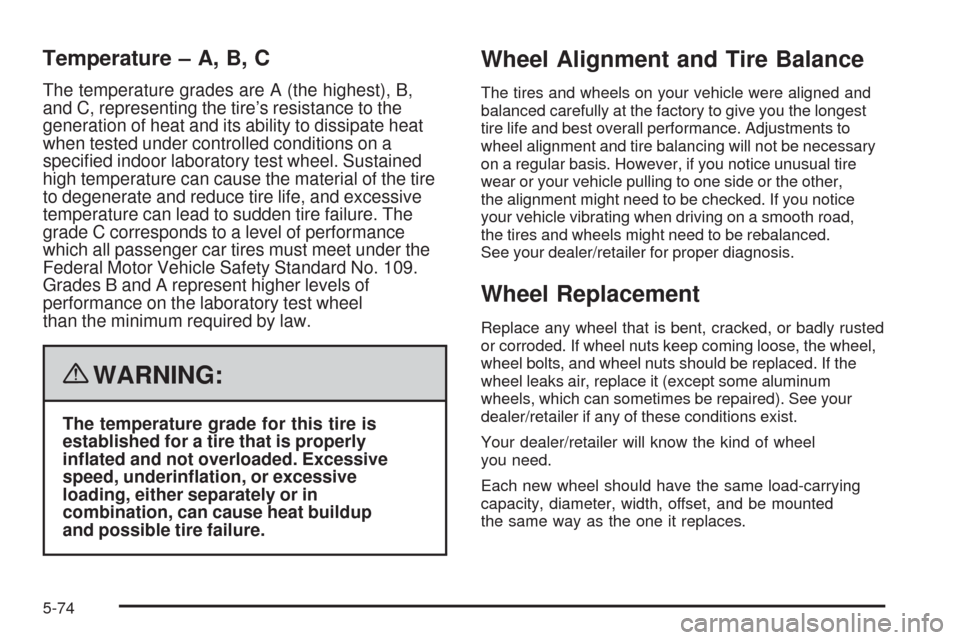
Temperature – A, B, C
The temperature grades are A (the highest), B,
and C, representing the tire’s resistance to the
generation of heat and its ability to dissipate heat
when tested under controlled conditions on a
speci�ed indoor laboratory test wheel. Sustained
high temperature can cause the material of the tire
to degenerate and reduce tire life, and excessive
temperature can lead to sudden tire failure. The
grade C corresponds to a level of performance
which all passenger car tires must meet under the
Federal Motor Vehicle Safety Standard No. 109.
Grades B and A represent higher levels of
performance on the laboratory test wheel
than the minimum required by law.
{WARNING:
The temperature grade for this tire is
established for a tire that is properly
in�ated and not overloaded. Excessive
speed, underin�ation, or excessive
loading, either separately or in
combination, can cause heat buildup
and possible tire failure.
Wheel Alignment and Tire Balance
The tires and wheels on your vehicle were aligned and
balanced carefully at the factory to give you the longest
tire life and best overall performance. Adjustments to
wheel alignment and tire balancing will not be necessary
on a regular basis. However, if you notice unusual tire
wear or your vehicle pulling to one side or the other,
the alignment might need to be checked. If you notice
your vehicle vibrating when driving on a smooth road,
the tires and wheels might need to be rebalanced.
See your dealer/retailer for proper diagnosis.
Wheel Replacement
Replace any wheel that is bent, cracked, or badly rusted
or corroded. If wheel nuts keep coming loose, the wheel,
wheel bolts, and wheel nuts should be replaced. If the
wheel leaks air, replace it (except some aluminum
wheels, which can sometimes be repaired). See your
dealer/retailer if any of these conditions exist.
Your dealer/retailer will know the kind of wheel
you need.
Each new wheel should have the same load-carrying
capacity, diameter, width, offset, and be mounted
the same way as the one it replaces.
5-74
Page 411 of 412
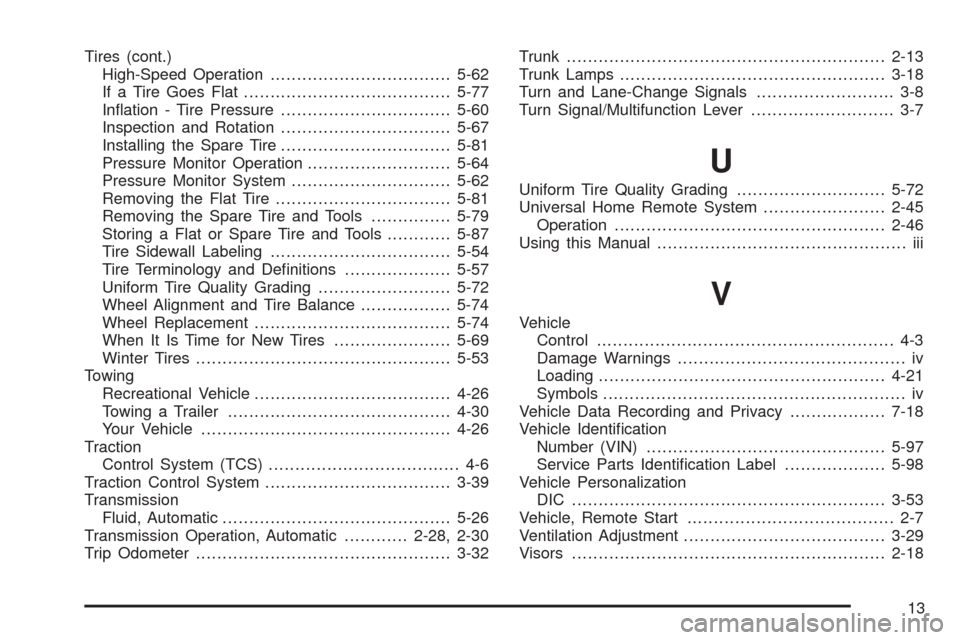
Tires (cont.)
High-Speed Operation..................................5-62
If a Tire Goes Flat.......................................5-77
In�ation - Tire Pressure................................5-60
Inspection and Rotation................................5-67
Installing the Spare Tire................................5-81
Pressure Monitor Operation...........................5-64
Pressure Monitor System..............................5-62
Removing the Flat Tire.................................5-81
Removing the Spare Tire and Tools...............5-79
Storing a Flat or Spare Tire and Tools............5-87
Tire Sidewall Labeling..................................5-54
Tire Terminology and De�nitions....................5-57
Uniform Tire Quality Grading.........................5-72
Wheel Alignment and Tire Balance.................5-74
Wheel Replacement.....................................5-74
When It Is Time for New Tires......................5-69
Winter Tires................................................5-53
Towing
Recreational Vehicle.....................................4-26
Towing a Trailer..........................................4-30
Your Vehicle...............................................4-26
Traction
Control System (TCS).................................... 4-6
Traction Control System...................................3-39
Transmission
Fluid, Automatic...........................................5-26
Transmission Operation, Automatic............2-28, 2-30
Trip Odometer................................................3-32Trunk............................................................2-13
Trunk Lamps..................................................3-18
Turn and Lane-Change Signals.......................... 3-8
Turn Signal/Multifunction Lever........................... 3-7
U
Uniform Tire Quality Grading............................5-72
Universal Home Remote System.......................2-45
Operation...................................................2-46
Using this Manual............................................... iii
V
Vehicle
Control........................................................ 4-3
Damage Warnings........................................... iv
Loading......................................................4-21
Symbols......................................................... iv
Vehicle Data Recording and Privacy..................7-18
Vehicle Identi�cation
Number (VIN).............................................5-97
Service Parts Identi�cation Label...................5-98
Vehicle Personalization
DIC ...........................................................3-53
Vehicle, Remote Start....................................... 2-7
Ventilation Adjustment......................................3-29
Visors...........................................................2-18
13
Page 412 of 412
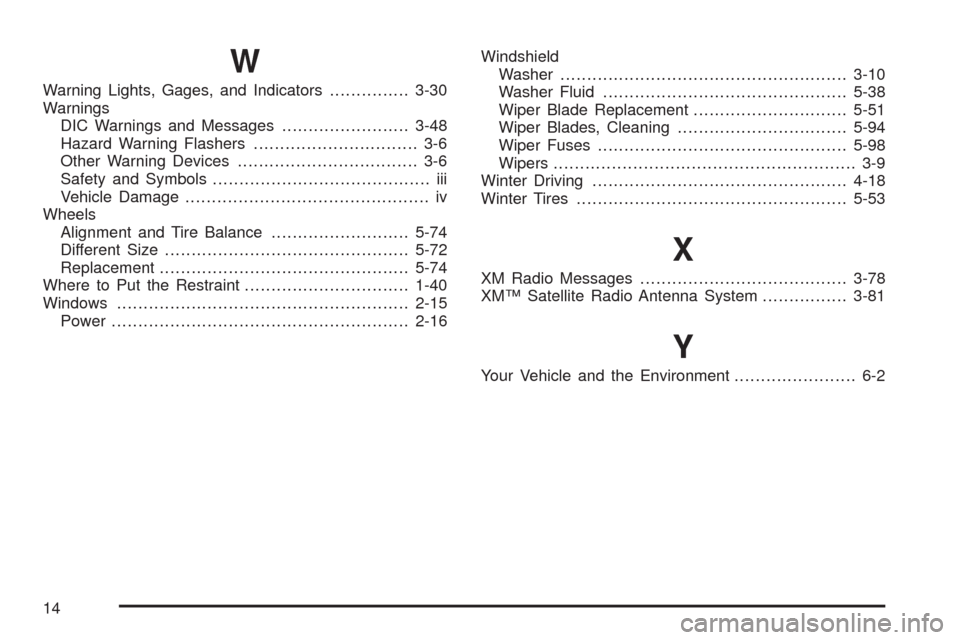
W
Warning Lights, Gages, and Indicators...............3-30
Warnings
DIC Warnings and Messages........................3-48
Hazard Warning Flashers............................... 3-6
Other Warning Devices.................................. 3-6
Safety and Symbols......................................... iii
Vehicle Damage.............................................. iv
Wheels
Alignment and Tire Balance..........................5-74
Different Size..............................................5-72
Replacement...............................................5-74
Where to Put the Restraint...............................1-40
Windows.......................................................2-15
Power ........................................................2-16Windshield
Washer......................................................3-10
Washer Fluid..............................................5-38
Wiper Blade Replacement.............................5-51
Wiper Blades, Cleaning................................5-94
Wiper Fuses...............................................5-98
Wipers......................................................... 3-9
Winter Driving................................................4-18
Winter Tires...................................................5-53
X
XM Radio Messages.......................................3-78
XM™ Satellite Radio Antenna System................3-81
Y
Your Vehicle and the Environment....................... 6-2
14